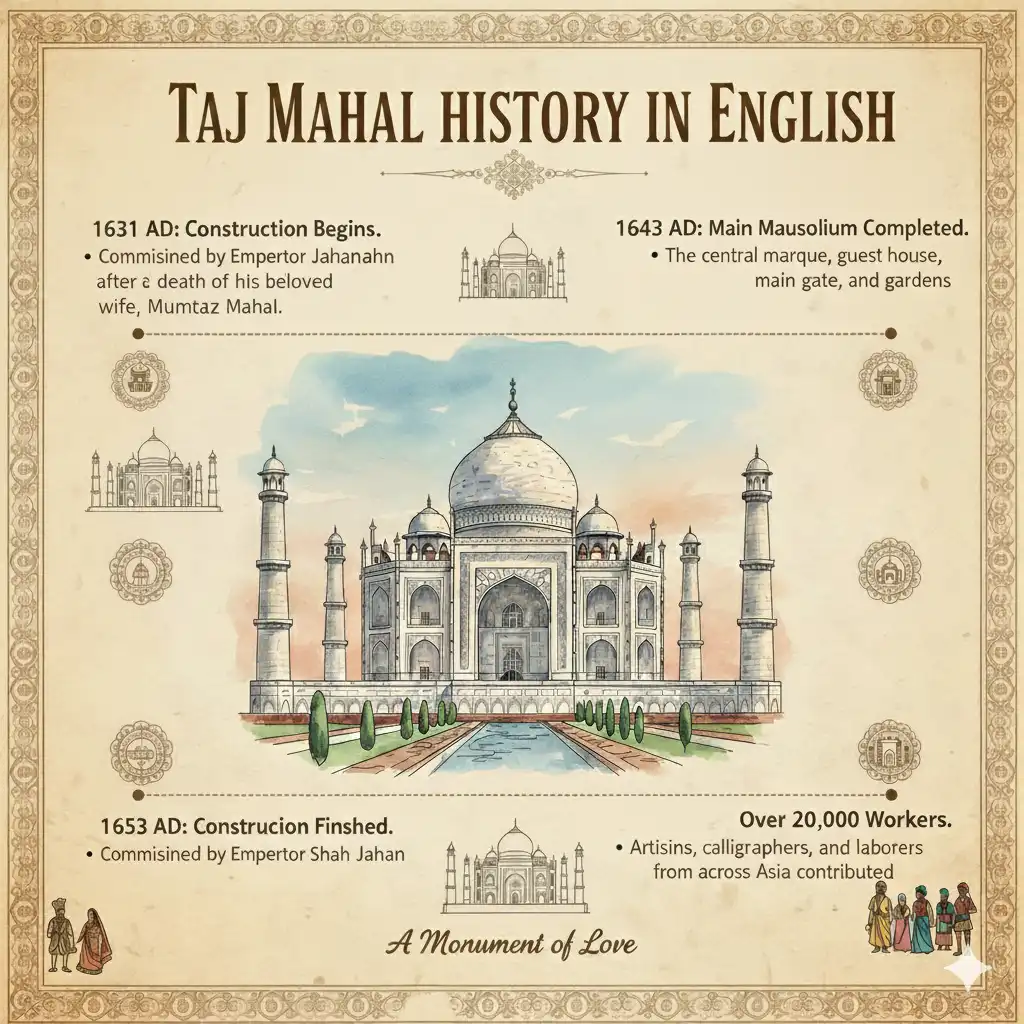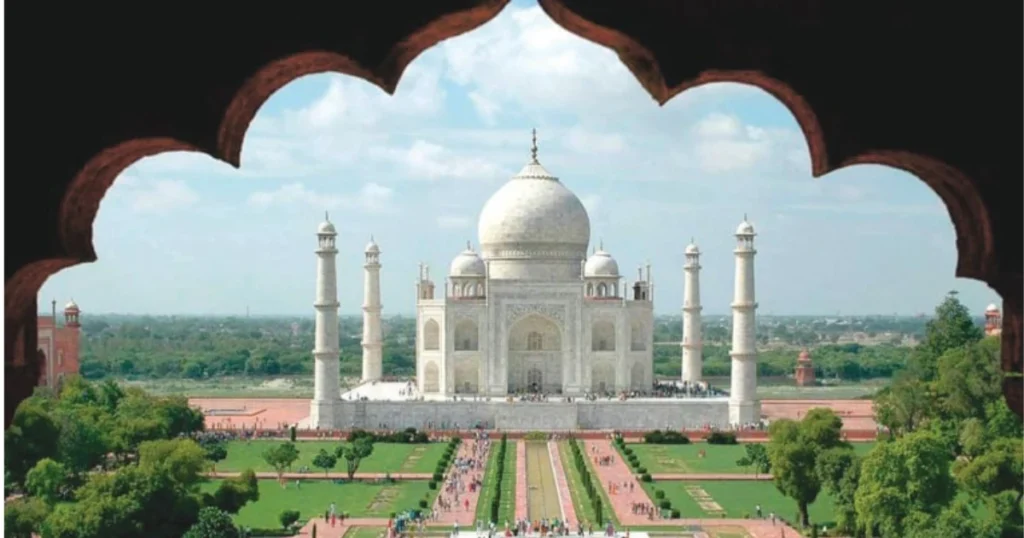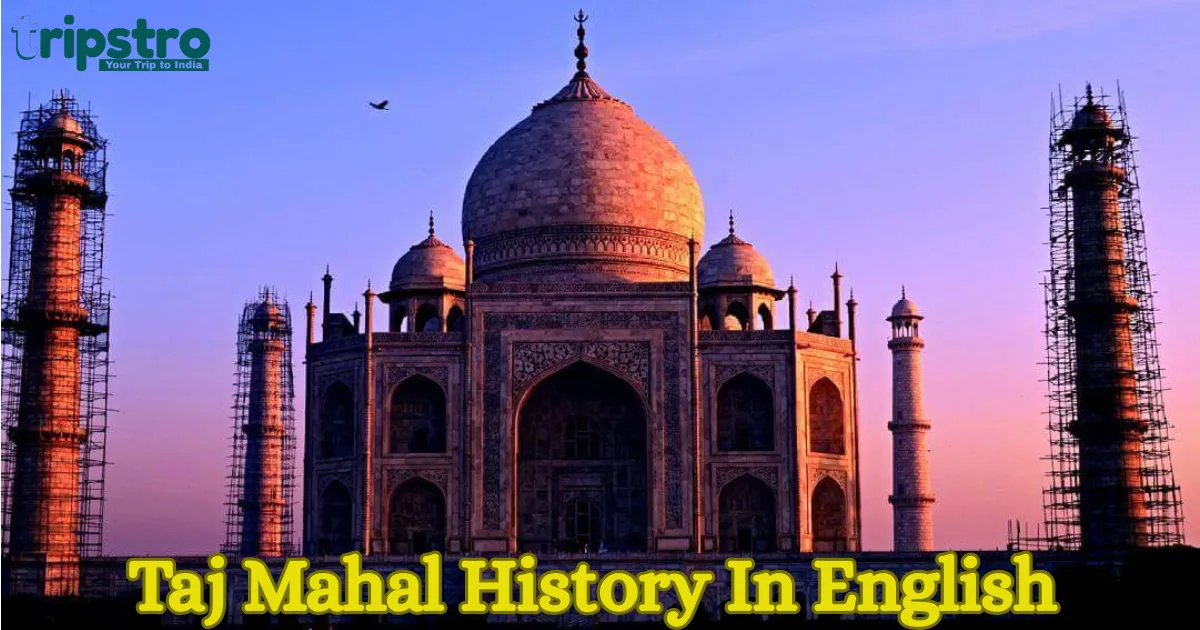The Taj Mahal History in English is not just about marble and domes—it’s a story that captures the very essence of love and legacy. Located in Agra, Uttar Pradesh, this iconic white marble mausoleum was built in the 17th century by Mughal Emperor Shah Jahan to honor his beloved wife, Mumtaz Mahal. Recognized as one of the Seven Wonders of the World, it continues to attract millions of travelers, writers, and historians who seek to experience its beauty and mystery.
At Tripstro, we take pride in offering not only travel experiences but also the stories behind them. And when it comes to heritage, few monuments are as powerful as the Taj Mahal. This guide will take you deep into the History of the Taj Mahal in English, along with must-know travel tips, nearby attractions, and the fascinating details that make this monument timeless.
The Story Of Taj Mahal In English: A Tale Of Eternal Love
The story of the Taj Mahal in English begins with Shah Jahan, one of the greatest Mughal emperors, and his wife Mumtaz Mahal. Their love story has become immortalized through this monument. Mumtaz, who accompanied Shah Jahan in his military campaigns, died tragically in 1631 during childbirth. Her last wish was that her husband never forget their love.
Shah Jahan, stricken with grief, commissioned the construction of the Taj Mahal in 1632 as a final resting place for his queen. Over 20,000 artisans, architects, and workers from across India, Persia, and Central Asia worked tirelessly for 22 years to bring this vision to life. The biography of the Taj Mahal in English reminds us that the monument is not just about its grandeur but also about human emotion. Every arch, dome, and garden reflects Shah Jahan’s devotion, making it a masterpiece born out of love and sorrow.

History Of The Taj Mahal In English: Construction & Architecture
When people search for the history of the Taj Mahal in English, they often wonder why it stands out among other monuments. The answer lies in its meticulous design and architectural innovation.
- Foundation & Construction: Built between 1632–1653, using Makrana white marble transported by elephants and oxen.
- Design Influence: Combines Persian, Islamic, and Indian architectural styles.
- Inlay Work: The marble walls are decorated with intricate pietra dura inlays of semi-precious stones like jasper, jade, and turquoise.
- Symmetry & Gardens: The entire complex is based on perfect symmetry, with a reflecting pool that doubles the beauty of the central dome.
| Key Facts About the Taj Mahal | Details |
| Built By | Emperor Shah Jahan |
| For | Mumtaz Mahal |
| Location | Agra, Uttar Pradesh |
| Material | Makrana White Marble |
| Time to Build | 22 years (1632–1653) |
| UNESCO Status | World Heritage Site (1983) |
Interestingly, historians believe the Tomb of Itmad-ud-Daulah in Agra, often called the “Baby Taj,” served as an architectural inspiration for the Taj Mahal.
Information About The Taj Mahal In English: Symbolism & Meaning
Beyond its architectural brilliance, the Taj Mahal carries deep symbolic meaning. Many travelers searching for information about the Taj Mahal in English are fascinated by its spiritual and emotional significance.
- The Dome: Represents the heavens and the eternal afterlife.
- The Gardens: Laid out in the charbagh style, symbolizing paradise as described in the Quran.
- Calligraphy: Verses from the Quran are inscribed in black marble around the arches, emphasizing peace and divinity.
The story about the Taj Mahal in English teaches us that beauty and meaning can coexist. Unlike many other monuments, the Taj is not only a resting place but also a symbol of eternal harmony between love, art, and faith.
How To Reach The Taj Mahal
Agra is one of the most visited cities in India, and reaching the Taj Mahal is simple and convenient.
- By Air: Agra Airport (12 km from the Taj Mahal) offers limited flights, while Delhi’s Indira Gandhi International Airport (230 km) is the most connected hub.
- By Train: Agra Cantt Railway Station has regular trains from Delhi, Jaipur, and other major cities.
- By Road: The Yamuna Expressway makes the Delhi–Agra drive quick and comfortable in about 3–4 hours.
For travelers wanting a broader cultural journey, packages like the 5 Day Golden Triangle Tour India (Delhi, Agra, Jaipur) offer the perfect introduction to India’s heritage.

Best Time To Visit The Taj Mahal
Timing matters if you want to experience the Taj at its best:
- Sunrise & Sunset: The marble changes color with the light, appearing golden at sunrise and pinkish at sunset.
- Winter (Oct–Mar): Pleasant weather makes it the best time for sightseeing.
- Full Moon Nights: A rare and magical opportunity to witness the Taj under moonlight.
Nearby Places To Visit Along With The Taj Mahal
Agra offers much more than the Taj Mahal. Some of the most important nearby attractions include:
- Agra Fort – Once the seat of the Mughal Empire, with stunning palaces and mosques.
- Mehtab Bagh – A riverside garden with the best sunset views of the Taj.
- Fatehpur Sikri – A historic city and UNESCO site about 40 km from Agra.
- Tomb of Itmad-ud-Daulah – The “Baby Taj,” with delicate marble latticework.
- Local Agra Markets – Known for marble souvenirs, handicrafts, and Mughlai cuisine.
If you’re extending your trip, don’t miss the Top 10 Attractions in Delhi, Agra & Jaipur, which together showcase the finest of Mughal and Rajput heritage.
Why The Taj Mahal History In English Inspires The World
The Taj Mahal History in English Wikipedia entries may provide the facts, but to truly understand it, you need to see it yourself. This monument isn’t just about architecture—it’s about experiencing emotion through art. From poets to travelers, everyone describes the Taj Mahal as something beyond words. It is not just India’s crown jewel but a symbol of universal love and devotion. At Tripstro, we invite you to walk through its gates, feel the soft marble under your hands, and let the story of the Taj Mahal in English remind you that love, when eternal, becomes art.
Conclusion
The History of the Taj Mahal in English is a powerful blend of history, love, and timeless beauty. Whether you’re searching for biography of the Taj Mahal in English, information about the Taj Mahal in English, or simply planning how to reach it, this guide ensures you are well-prepared. So, don’t just read about the Taj—experience it. Walk its marble floors, explore its gardens, and let the sunrise over the Yamuna take your breath away. Plan your journey today with Tripstro and make the Taj Mahal History in English part of your own story.
FAQs
Q: What is the history of the Taj Mahal in English?
Ans. It was built by Shah Jahan between 1632–1653 as a mausoleum for Mumtaz Mahal, symbolizing eternal love.
Q: What is the story of the Taj Mahal in English?
Ans. The Taj represents Shah Jahan’s devotion to Mumtaz Mahal, blending beauty, architecture, and emotion.
Q: How can I reach the Taj Mahal from Delhi?
Ans. You can travel by train, road via the Yamuna Expressway, or flights connecting to Agra Airport.
Q: What are the nearby attractions to the Taj Mahal?
Ans. Agra Fort, Fatehpur Sikri, Mehtab Bagh, and the Tomb of Itmad-ud-Daulah are must-see.
Q: What is the best time to visit the Taj Mahal?
Ans. Winter months (October–March) and sunrise or sunset hours are the best times for breathtaking views.





 //
//
